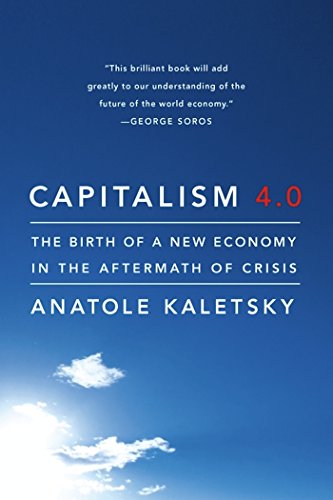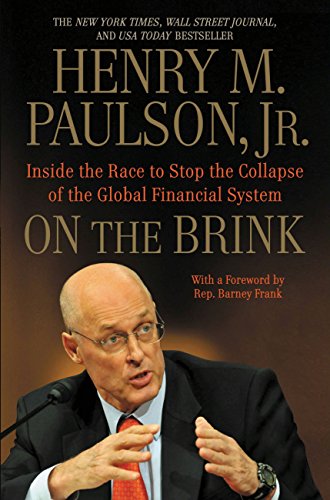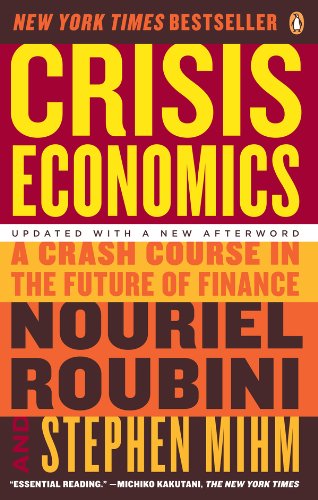Does Capitalism Have a Future?
Capitalism 4.0: The Birth of a New Economy in the Aftermath of Crisis
Anatole Kaletsky. 2010. Perseus Books Group, PublicAffairs, New York. 416 pages.
On the Brink: Inside the Race to Stop the Collapse of the Global Financial System
Henry M. Paulson, Jr. 2010. Grand Central Publishing, Business Plus, New York. 496 pages.
Crisis Economics: A Crash Course in the Future of Finance
Nouriel Roubini and Stephen Mihm. 2010. Penguin Group, The Penguin Press, New York. 368 pages.
As the decade draws to a close, many of the world’s major economies are still struggling to regain some sense of stability following the worst economic reversal since the Great Depression of the 1930s. Countless individuals, corporations and even nations in the developed world find themselves in financial straits, unsure of a future that once seemed so bright.
In the wake of the 2007–09 financial crisis, a number of economists and commentators have written books in an effort to establish why the crisis happened, and how the capitalist system might be able to move forward successfully. Here we review three recent examples.
An Economic Rebirth?
“The world did not end.” So begins Anatole Kaletsky’s Capitalism 4.0, which argues that following the recent financial crisis, “global capitalism will be replaced by nothing other than global capitalism.”
Kaletsky’s certainty is founded on his sense that capitalism is ultimately tied to our humanity. In no way did the crisis “destroy nor diminish the fundamental human urges that have always powered the capitalist system—ambition, initiative, individualism, the competitive spirit.” It is these innate urges, reminiscent of John Maynard Keynes’s “animal spirits,” that will ensure the creation of “a new version of capitalism.” In other words, as Patrick Minford (professor of applied economics at Cardiff Business School) expressed in a June 2010 debate with Kaletsky in London, “the phoenix will reboot.”
One might argue Kaletsky’s position that these urges are all positive human qualities. This is not to say that he thinks capitalism is perfect, however. He doesn’t. He believes that inevitably there will be problems, and that it is these problems that the next version of capitalism must now address. He makes it clear that neither investors nor bankers nor former Federal Reserve chairman Alan Greenspan had any idea what an appropriate credit limit was, because it was and is unknown to them—outside their field of vision; yet ironically, despite this inherent blindness, the show must go on.
The impossibility for individual human beings to predict or control the future of a system powered by “human urges” was, for Kaletsky, compounded by “the demystification of money [which] meant that debt ceased to be a moral or theological issue and became just another consumer product.”
Certainly Kaletsky is exceedingly well qualified to express an opinion on global capital markets, having built a long career as a business and finance journalist with The Economist, the Financial Times and The Times of London. He puts this knowledge and experience to good use as he places the present crisis into its historical context.
Capitalism 4.0 posits three broad versions or ages of capitalism, each initiated by a period of upheaval. Kaletsky identifies each age with the politicians or economists who codified it and those who destroyed it. For example, the most recent iteration, which he calls Capitalism 3, began with Margaret Thatcher, Ronald Reagan and economist Milton Friedman and ended with George W. Bush, Henry (Hank) Paulson and Greenspan.
It is with the mention of Paulson, treasury secretary under the Bush administration (2006–2009), that Kaletsky introduces what he acknowledges to be the most controversial argument put forward by the book—“that the primary reason for this disaster was not the stupidity of regulators, the greed of bankers, or the improvidence of speculators in low-income real estate but a series of misjudgments made by one man: U.S. Treasury Secretary Henry Paulson.” In Kaletsky’s view, an erroneous market fundamentalism nurtured under Capitalism 3 led to a failure to see the essential role of swift government intervention when needed. The irony for Kaletsky is that “a U.S. treasury secretary and former Goldman Sachs chairman had come closer to destroying capitalism than Marx, Lenin, Stalin, and Mao Ze Dong combined.”
What Capitalism 4.0 will need to deliver, in Kaletsky’s view, is greater government involvement. On the surface, this would sound like wisdom. Market fundamentalism would, in the end, lead to collapse unless a governing authority could effectively intervene and regulate. However, one must ask whether it is ever really possible, in the long term, for people to avoid systemic catastrophe, particularly as the flaws or “urges” that power that system lie with us?
It remains to be seen whether Kaletsky’s prediction for greater government control in a climate of increasing globalization will come to pass. For him the moral impetus lies in fending off the authoritarian approach to capitalism represented by China, and maintaining the liberal-democratic capitalism of the West.
Depending on where we stand in the world, this, too, may sound like good policy. However, such a turn of events would not be a moral victory any more than the dominance of an authoritarian capitalism would be. Rather it would be a capitulation into the idea on which Kaletsky’s book and economic theory are founded—that capitalism is “an evolutionary system that reinvents and reinvigorates itself through crises.” This would seem to be true. The particulars of capitalism and its administration do slowly change, reinvent and reinvigorate in response to crises, but only as a human construct that leads to inevitable cycles of boom and bust. Just because the system does allow for an upward trend and the generation of wealth, this does not mean that it isn’t defined and characterized by inevitable collapse and ruin, nor that we are any less bound to it.
Holding the System Together
Hank Paulson had little in the way of hindsight to guide his judgments and decisions as the financial crisis unfolded. On the Brink is his entirely personal blow-by-blow account from inside the camp of those tasked with staving off the impending disaster. The book generates an acute sense of the relentless pressure that the U.S. government, the Federal Reserve and the treasury were under during the crisis. The result is an exciting book that marries human interest to Paulson’s unique perspective and involvement in truly dramatic events.
“I had come to Washington to make a difference, and we had, I thought, just saved the country—and the world—from financial catastrophe.”
His account goes a long way in verifying Kaletsky’s assessment of his non-interventionist perspective. Paulson, like many in the Bush administration, was utterly averse to the idea of bailing out financial institutions with taxpayers’ money. He also verifies Kaletsky’s sense that the machinery of regulation and government did not keep up with the development of markets, nor particularly with the increasingly intertwined nature of financial institutions. He suggests that the government was limited in being able to move quickly enough: “Frankly we had no choice but to fly by the seat of our pants, making it up as we went along.”
The book delivers a clear sense of Paulson’s frustration: “We couldn’t keep using duct tape and baling wire to try to hold the system together.” Much of this frustration is geared toward the machinery of politics in which the TARP (Troubled Asset Relief Program) legislation became mired. At times the political divisions would seriously impede progress toward a solution, with accounts of meetings between Democrats and Republicans where participants descended into “speaking over each other,” “yelling” and “full-fledged shouting around the table.”
Where Paulson’s account conflicts with Kaletsky’s, of course, is in where the blame lies. Paulson traces the root of the problem to the mortgage market and “living beyond our means,” and concedes that although he “anticipated” a problem, he did not foresee that it would come from that quarter. At times he clearly demonstrated what Kaletsky criticizes as a zealous market fundamentalism that firmly believed in allowing the system to self-correct.
Doubtless, Paulson has precisely the experience required to give an inside account of the crisis. But as Kaletsky charges, he was reluctant to intervene; indeed, the systems of intervention were simply not in place when required. However, just as Paulson is qualified to give this account, it may be argued that few were more qualified to handle the crisis in terms of understanding markets and financial institutions than this former CEO of Goldman Sachs. If he was unable to perform flawlessly, then who could?
Paulson enjoyed an academic, sporting and career record of excellence. He gives an account of himself in his role with Goldman Sachs as something of a “crusader” and a “moralist” who would chide his colleagues for living excessive lifestyles, urging that “in business, as in life, we should do not just what is legal but what is right.”
What is less well known about Paulson is that he is a Christian Scientist. The religion, which is perhaps most often associated with prohibiting the use of medication for healing, traces its roots back to the writings of Mary Baker Eddy. Paulson notes that Christian Science “has always been a big influence” on him. He recounts his ultimately successful struggle to resist taking sleeping pills when in desperate need of sleep amid the turmoil of the ailing financial system. Whether Paulson’s beliefs informed his reluctance to administer swift and effective intervention to the financial system is never overtly expressed in the book. Certainly it was something he reached out for when under extreme stress. He writes that on one occasion he called his wife, whom he records as saying, “You needn’t be afraid. Your job is to reflect God, infinite Mind, and you can rely on Him.”
While Kaletsky’s and Paulson’s accounts differ in important respects, both demonstrate that capitalism and the way in which it is administered can’t help but be a reflection of who we are and what we believe to be right.
Road Map to a Crisis
In Crisis Economics, academics Nouriel Roubini and Stephen Mihm provide a balanced account of the recent financial crisis that is both appropriately historical and global in its approach. While accounting for the importance of the United States in how things unfolded, the analysis benefits from a more international perspective. In a similar sense the historical span of the book is far wider than Paulson’s in-the-moment thoughts could possibly be, and farther ranging than Kaletsky’s neat packaging of capitalism’s history. Its central thesis (as the title suggests) concerns crisis economics, clearly demonstrating that “far from being the exception, crises are the norm, not only in emerging but in advanced industrial economies.” Such crises have always been with us and so they will remain (see “Mortally Wounded: Global Finance and Banking—Systems in Crisis”). The book makes the case that “crises are hardwired into the capitalist genome.”
“In the history of modern capitalism, crises are the norm, not the exception.”
Roubini might well feel that he has the right to speak on the subject, having sounded a warning in September 2006 that a catastrophic burst of the U.S. housing bubble was coming. The book also clearly benefits from Mihm’s depth of historical knowledge, noting that “history promotes humility,” or at least a historical perspective should. This is most effective in identifying how far beyond the subprime mortgage bubble the roots of the present crisis go, an analysis that follows an account of older crises and how economists interpreted them. Roubini and Mihm argue that the events of 2008 would have been familiar to the financial observers of one hundred or even two hundred years ago, despite inevitable differences in the particulars of each crisis and certain unique elements that surfaced for the first time in the recent collapse.
The book is a road map of how we got into the crisis—of how and why markets fail. The authors argue that blaming greed is a “tired explanation.” They point out that the recent crisis was different not because of an increase in greed but because of a dangerous redirecting of greed through new channels of compensation.
As they offer possible solutions for getting out of this mess, and staying out, their argument becomes less convincing, however. Though their emphasis on the imperfections of markets is a refreshing counterbalance to the number of economists determined to show that markets work efficiently, it is hard to believe that their ideas for improvement will ever come to fruition. Like Kaletsky, they lament that quicker and smarter government did not intervene more when the crisis struck, and also that better regulatory infrastructure was not in place. They call for a range of regulations that wouldn’t remove the financial tools, such as securitizations and derivatives (which grew so septic in the build-up to the current crisis), but would better control them and bring them into public view. A “beefed-up version” of the 1933 Glass-Steagall Act, part of the banking reform adopted in response to the collapse of large sections of the American commercial banking system by early 1933, would, they suggest, move financial activity out of the shadows and into the light.
However, although they remain optimistic that with the right measures, future crises could be avoided, they are also alert to the fact that little regulation has actually emerged since the current crisis erupted. This issue, combined with the huge global imbalances at the national level between countries with large trade surpluses and burgeoning deficits (such as China and the United States), could set the stage for a future crisis on a scale never before seen. Thus they contend that “the recent financial disaster may be a taste of things to come.”
If Roubini and Mihm’s sense is correct—that “the financial crisis merely ripped the sleek and shiny skin off what had become, over the years, a gangrenous mess”—then will propping up this system ever lead to real and long-lasting success? Whatever the answer, it sounds as if we have no choice but to try to resuscitate it.
A Flawed System
Though at times radically different in their interpretation of the latest crisis and what should be done to prevent future catastrophes, these three books do identify several related themes. Capitalism and our approach to it goes back to us; it reflects what we are and where we are coming from. There is no human being, no matter how well qualified, who can keep a grip on every possible eventuality, remain immune from self-interest, predict every turn of events, and control the system to the point of avoiding disaster. Further, these books demonstrate that the appetite to do everything we can to prop up a deeply fallible system, despite the risks, is still alive and well, regardless of the sense that other, perhaps bigger catastrophes lie ahead.
What none of these authors provides is an alternative to the economic system that we have chosen, believing it (though flawed) to be the best option available. They have faith in the present system. But if we know that this system is founded on aspects of human nature that are in fact often selfish—in Kaletsky’s words, “ambition, initiative, individualism, the competitive spirit”—then isn’t it fair to suggest that a true solution requires changing or redirecting these elements within us? And if we cannot do that ourselves, as the state of the present system strongly suggests, then are we as individuals even free to put down the tools of capitalism? Are we so enslaved by our own nature that we cannot allow ourselves to be shown the way to a system that is truly good, lasting and rightly governed? Perhaps it’s time to look beyond ourselves to the infallible Being who can change the desires of the human heart and cure us of the “urges” of self-interest and gain.



